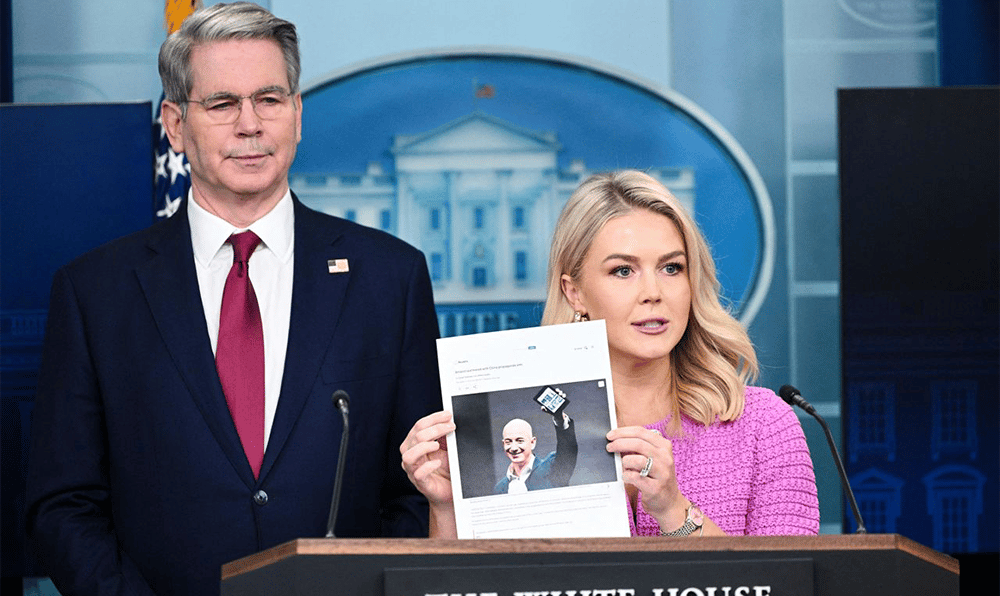Amazon vs. the White House: The Tariff Transparency Battle Heating Up
4/29/20254 min read


Amazon vs. the White House: The Tariff Transparency Battle Heating Up
Introduction: A Clash of Titans
In a dramatic showdown that’s got everyone talking, Amazon and the White House are locking horns over a controversial idea: displaying the cost of President Trump’s tariffs on products sold through Amazon’s low-cost Haul platform. The e-commerce giant considered this move to highlight how new tariffs—up a staggering 145% on Chinese goods since Trump took office—are driving up prices. But the White House, through Press Secretary Karoline Leavitt, slammed the idea as a “hostile and political act,” sparking a fiery debate about transparency, trade policy, and who really pays the price for tariffs. Let’s dive into this unfolding saga and what it means for consumers like you.
The Tariff Trouble: What’s at Stake?
President Trump has made tariffs a cornerstone of his trade policy, aiming to boost American manufacturing by taxing imports, especially from China. His recent executive order closed the “de minimis” loophole, which previously allowed low-value packages from China to enter the U.S. duty-free—a move that hit platforms like Amazon Haul, Temu, and Shein hard. These platforms thrive on affordable, China-sourced goods, but with tariffs now at 145%, prices are climbing fast. Automakers and retailers like Walmart and Target have warned of higher costs and empty shelves, while small businesses selling on Amazon are scrambling to adapt.
Amazon’s Haul platform, launched to compete with budget giants like Temu, briefly considered a bold move: showing tariff costs alongside product prices. The goal? Transparency—letting consumers see exactly how much of their bill comes from Trump’s tariffs. But before the plan could take off, the White House intervened, and Amazon backed down.
The White House Strikes Back
White House Press Secretary Karoline Leavitt didn’t mince words, calling Amazon’s tariff transparency plan a “hostile and political act.” She questioned why Amazon didn’t take similar action during Biden’s administration when inflation soared to a 40-year high. Leavitt even pointed to Amazon’s past partnerships with Chinese firms, framing the company’s actions as unpatriotic and urging Americans to “buy American.” President Trump himself got involved, reportedly calling Amazon founder Jeff Bezos to voice his displeasure. According to a White House official, Bezos “solved the problem quickly” by scrapping the idea, a move Trump praised publicly.
The backlash was swift—Amazon’s stock dropped 2% as the news broke. But Amazon clarified that the tariff display was only ever considered for Haul, not its main site, and was ultimately rejected. Still, the episode has reignited a broader debate about who tariffs really hurt: the government says they protect American jobs, but critics argue they’re a hidden tax on consumers.
What’s the Big Deal About Transparency?
Amazon’s idea to show tariff costs wasn’t just about pricing—it was a statement. Consumers have a right to know why prices are rising, especially when tariffs are a direct cause. Senate Democratic Leader Chuck Schumer supported this view, urging retailers to “show your customers how much tariffs are hurting their pocketbooks.” On X, users like @EdKrassenechoed this sentiment, arguing, “Americans have a right to know. It’s not political. It’s logical!” Others, like@JoshNitsche, pointed out the White House’s discomfort: “They don’t want the tariff tax shown because they’ve spent weeks claiming tariffs don’t affect the consumer, and this is evidence that it does.”
On the flip side, the White House sees Amazon’s move as a political jab, especially given the timing. With nearly 2 out of 3 Americans disapproving of Trump’s tariff policies (according to a Washington Post-ABC News-Ipsos poll), the administration is sensitive to any narrative that paints tariffs as a burden on consumers. X user@dougboneparthcaptured the tension humorously: “Amazon: Tariffs are making things more expensive. White House: No, they aren’t. Amazon: shows prices with tariffs. White House: This is a hostile and political act!”
The Consumer Impact: Who Pays the Price?
For shoppers, this clash raises a critical question: Who’s really footing the bill for tariffs? Economists largely agree that tariffs act like a tax, often passed on to consumers through higher prices. Retailers like Temu have already started listing “import charges” to reflect tariff costs, and Amazon’s Haul platform, reliant on Chinese goods, is particularly vulnerable. Small businesses selling on Amazon are feeling the heat, too—many are pausing shipments or rethinking suppliers to avoid the tariff hit, which could mean fewer deals for consumers during events like Prime Day.
Meanwhile, the White House is doubling down on its “buy American” message. X user@RichardGrenelleven suggested Amazon add a “Made in America” filter to help shoppers avoid Chinese goods—a feature that could align with Trump’s push for domestic manufacturing but might limit options for budget-conscious buyers.
What’s Next for Amazon and Tariffs?
This isn’t the end of the story. Amazon’s retreat from its tariff transparency plan may have calmed tensions for now, but the underlying issues remain. Tariffs are reshaping global trade, and as prices rise, consumers will demand answers. Will other retailers follow Temu’s lead and start breaking down tariff costs? Or will political pressure keep companies silent? One thing’s clear: the battle between corporate transparency and government policy is far from over.
Thought-Provoking Questions for Readers
Do you think Amazon should have stuck to its plan to show tariff costs, even if it meant political backlash?
How much transparency do you expect from companies about the impact of government policies like tariffs?
Would you be more likely to “buy American” if Amazon added a filter for U.S.-made products, or do you prioritize price over origin?
Let me know your thoughts in the comments—I’d love to hear how this issue is affecting your shopping habits!
Photo Credit: GettyImage
hello@boncopia.com
+13286036419
© 2025. All rights reserved.